The Digital Imperative for CMOs | BCG
The Digital Imperative for CMOs From Responding to Rebounding Through Technology
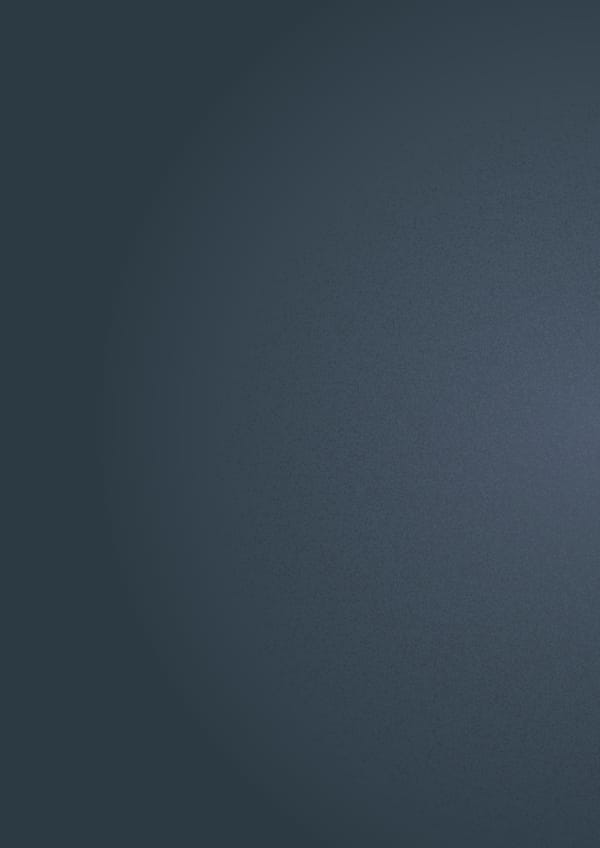
Table of Contents 5 Executive Summary 6 Introduction 8 There’s No Returning to ‘Normal’ 8 Radical Digital Shift 10 Changing Sentiments 10 Invest into Technology 11 Five Steps 11 1 – Create Space 14 2 – Reassess Product/Market Fit 16 3 – Optimize Operations 18 4 – Leverage Technology, Capture Digital Growth Opportunities 20 5 – Plan and Invest 23 Key Takeaways 24 About the Authors 26 About BCG Digital Ventures
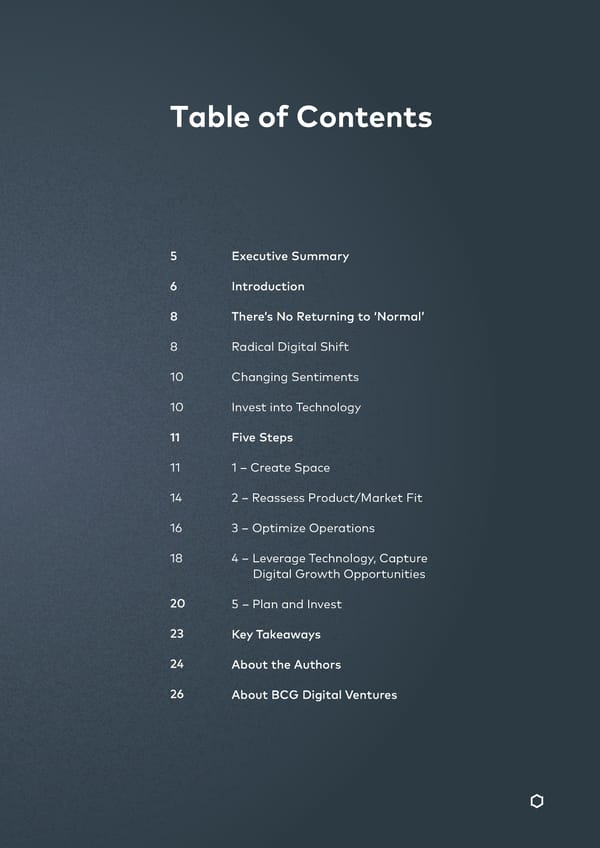

Executive Summary The COVID-19 crisis has presented a series of challenges for marketing and sales leaders, from radical changes in consumer sentiment to unpredictable behavior to threats to brand relevance. Responding to these challenges and rebounding strongly will come down to the smart use of marketing technologies, enabling CMOs and their teams to understand their consumers, protect market share, prepare for scalability and ultrapersonalization, and plan for the future. “Companies who are well set up to function online, who prioritize data analysis and automation, and who make decisions based on insights provided by bleeding-edge solutions, are well-positioned to come out of the crisis and rebound faster.” AMARYLLIS LIAMPOTI PARTNER AND DIRECTOR, BCG DIGITAL VENTURES
Introduction The COVID-19 crisis has presented a series of closely monitoring customer sentiment, challenges for marketing and sales leaders, marketers can future proof their businesses and from radical changes in consumer sentiment ensure relevance for the future, in a world that to unpredictable behavior to threats to brand is likely to look a lot different to before the crisis. relevance. As a Chief Marketing Officer, you have multiple issues to deal with at once. It’s no With this in mind, you need a tangible and surprise that, in a climate of great uncertainty, actionable set of tools and tactics alongside consumers are limiting their spending in certain an adaptive, dynamic outlook to manage your categories. BCG sentiment analysis found that brands, allocate resources, and speak and consumers expect to decrease their spending engage with customers. Equipped with this across multiple categories, with retail in toolset, you’ll be prepared to manage through particular heavily impacted, as can be seen in the initial period of upheaval, and ready your the graph on the following page from the most company to rebound. acute phase of the crisis. At the core of any new approach should be a Aside from the consumer squeeze, emotions focus on MarTech and other digital solutions are heightened. There are suddenly many more and the possibilities they offer. Getting through sensitivities and pitfalls that brands need to be the crisis and coming out stronger on the other aware of, some of which require radical pivots of side will require an agile, data-focused, and fluid planned campaigns or drastic changes in tone. approach. In order to keep this pace, you need On top of this, the lifestyle changes that have to be aware of the advantages new MarTech resulted from the crisis are sure to lead to both and digital capabilities can provide. An effective short- and long-term attitude shifts. Brands marketing operation in less challenging times are suddenly being challenged for relevance by should be underpinned by a strong deployment a new set of metrics and values. The landscape of the latest tools, but during a period of is changing and, as a CMO, you can’t afford upheaval these capabilities become central to for your team to be left behind. Understanding any strategy. these changes as they happen will be integral to protecting market share and laying the foundation for future success; new technologies that give marketing teams the ability to detect and respond to changes as they arise and adapt plans accordingly should be deployed. Beyond the initial crisis response, it’s also vital that you don’t lose perspective on the long term. The first priority for many companies has been to manage their day-to-day operations and protect revenue, but the crisis is also disrupting business models and altering market landscapes, causing changes that will be felt for years to come. By keeping an open mind to investment and innovation opportunities, reviewing and adapting their offerings, and
GRAPH 1 Category winners and losers in planned spending UK Ger US Can Ita Fr In-home entertainment Winners Fresh and organic foods More than 20% of respondents plan to Packaged food and beverages spend more Preventive Health Care Household care products Savings Utilities Restaurant pickup/delivery Out-of-home entertainment Medical procedures Vitamins/supplements Education UK Ger US Can Italy Fr Travel Losers Out-of-home entertainment More than 20% of Restaurants respondents plan to spend less Gambling Luxury/fashion Public transportation Home décor Women’s clothing Outerwear Athletic equipment and clothing Cars/Automobiles Home electronics and appliances Shoes/footwear Toys and games Mobile electronics Restaurant pickup/delivery Cosmetics/perfume Alcohol Savings Medical procedures Education Hair and body care Rent/mortgage In-home entertainment Utilities Insurance Vitamins/supplements Source: BCG COVID-19 Consumer Spending Survey, March 27th-30th, 2020 Note: Question text: 'How do you expect your spend to change in the next 6 months across the following areas?' Categories listed exclude baby/child food, childcare and children’s clothing.
There’s No Returning to ‘Normal’ Radical Digital Shift The COVID-19 crisis has accelerated behavioral shifts that were already in progress. Internet use is up 70% since the crisis began, and demographics which previously relied on physical retail stores or non-online business models are being forced to digitize. In March, online retail sales grew by 74% in average transaction volumes compared to the previous year. Customers are seeking out and interacting with External factors like budgets and industry- businesses more today than a month ago. This specific impacts from COVID-19 will inevitably is at least partially due to the fact that stay-at- affect sales cycles, but the data suggests home orders and business closures have moved businesses have an opportunity to attract many transactions online out of necessity, but it and engage interested customers and buyers shows that, for now, buyers are still looking to provided they can reach them where they engage. are: Online. Building and expanding digital capabilities is key to success in this new Mobile apps, for example, experienced a sharp environment; new customers and users on rise in usage in the first quarter of 2020, with new channels are more volatile and current new installs of apps rising as high as 132% models are unlikely to fit. That’s before taking over the same time last year, according to into account the rapidly changing external Adjust. Business apps that connect employees circumstances that will alter behavior. or help with productivity have seen a huge rise, with sessions —the frequency with which users actually open apps— climbing 105% from "Customers are seeking this time last year. Users are also opting for premium versions of business apps to help out and interacting with ease the transition to working from home, with businesses more today than revenue events that track purchases rising over 75%. Food and drink apps saw a significant a month ago. This is at least increase in sessions, up 73% from this time last year, as restaurants are forced to turn to partially due to the fact that takeout-only. Entertainment apps have also stay-at-home orders and trended higher, with installs rising 55% over the same time period. business closures have moved However, deal creation volume is down, a many transactions online decline that will impact most businesses’ sales out of necessity, but it shows forecasts. Responses to sales outreach have decreased too, suggesting that sales strategies that, for now, buyers are still need to be adjusted to reflect the current looking to engage." buying reality.
Full-funnel marketing orchestration technology with consumers and buyers as they progress can help gather new data throughout the through the buyer’s journey will now be integral buyer’s journey and help generate insights to success. that can inform activities and priorities. With more digital engagement, every marketer Furthermore, with advertising prices down, needs to invest in the tools to ensure they getting the most out of spend can help reap truly understand their customers; the ability huge rewards. With more inventory available to follow them throughout the funnel has at a cheaper cost, a smart digital advertising always been important, but with behavior strategy based on the fast-changing data having changed, and with new audiences collected through orchestration technology can and further changes on the horizon, having a help you drive down the customer acquisition comprehensive understanding of how to engage cost significantly and maximize lifetime value. GRAPH 2 Points of change in sales growth vs. pre-crisis (Dec-Jan) March 12-18 March 5-11 Feb 27-Mar 4 73 52 38 SE 24 INCREA 9 13 12 9 11 5 8 6 8 7 5 1 2 2 4 -2 -11 Home & DIY Amazon Online Electronic Mass Retail Pharmacy Grocery Groceries Retails -3 -2 -4 -4 -1 -7 -11 -9 -7 -10 -8 -9 -6 -12 -17 -12 -22 -23 -32 -34 -36 SE -38 DECREA -46 -56 Hobby Health, Restaurants Entertain- Dept Transport Apparel Travel Fitness, ment & Stores Beauty Cinemas Source: BCG Research

Changing Sentiments Finally eliminating technical debt in your Different demographics are displaying different marketing and tracking tools and building the attitudes to resuming their spending patterns. infrastructure your team needs to scale again is Understanding how to engage different the best way to rebound; reviewing your toolset audiences through digital tools and tailoring and renegotiating with providers is the first communications strategies will be key to step. success. These sentiments are likely to change in ways that are impossible to forecast, and so At BCGDV, we build businesses with scalability deploying tools to monitor behavior and alter as a core consideration. We know how crucial messaging to fit is vital. effective MarTech tools and digital capabilities are for a successful go-to-market. A volatile and traumatic environment requires marketers to protect their brand and adapt messaging with speed. With new audiences, uncertainty, and changeable economic "Product decisions and conditions, in-depth analysis, powered by insights brought about automation where possible, is the key to maintaining creativity without being left behind. by the crisis also need to Invest into Technology be understood through the Before the crisis, CMOs were already allocating lens of comprehensive more to MarTech than in previous years, data analysis." although 2019 saw a slight dip from the highs of 2018. To deal with the shift to digital and the volatile consumer and buyer landscape, you should consider a higher percentage allocation of budget from now onwards. GRAPH 3 CMO budget allocations across Focus should be placed squarely on efficiency major resources and scalability, with MarTech and other digital solutions driving your team to do more and boost performance in the short term while 2017 2018 2019 leaving room for expansion in the longer term. The move towards remote work has led to a heightened appreciation of the importance of 30% tools for teaming, and the introduction of a technology-focused approach to marketing is compatible with this shift; now is the time to invest and move towards all-in-one solutions and away from siloed, legacy tools. 20% With rapidly changing sentiment and new audiences, it’s also the time to commit to making your team fully data literate, leveraging data to fully understand where to invest, where to be more conservative, and where to allocate budget. Product decisions and insights brought about by the crisis also need to be understood through the lens of comprehensive data analysis. Martech Paid Agencies Labor Media
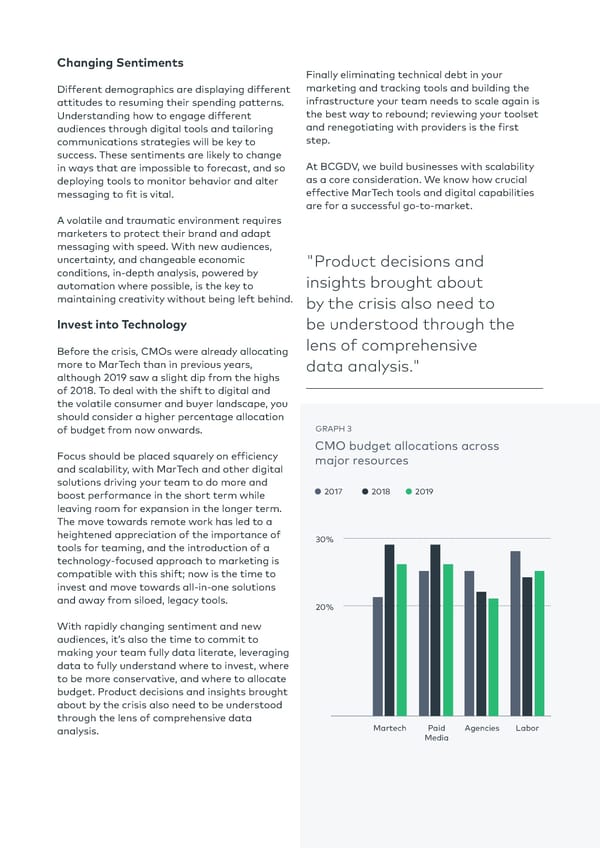
Five Steps Given the new landscape and the developing level engagement with products and value is situation, now is the time for marketers to take required; shifting product/market fit to suit a step back and understand the steps they need the new conditions and implementing MarTech to take to defend their position and set their solutions that anchor it in fluctuating consumer companies up to rebound. We have identified sentiment in real time will be the primary lever five steps that CMOs should work through during this stage. to put their companies in the best possible position. The next priority is to set your team up for operational success by collaborating across In this initial, acute period of the crisis, functions and teams, connecting with emphasis should be placed on creating space stakeholders, and implementing solutions that for the company. This includes a full review will enable you to accelerate growth and move of activities, campaigns, communications, with agility. Finally, it’s time to plan for the and spend, before quickly moving to invest future and make strategic investments in the into potential areas for growth. After the capabilities you’ll need for a strong rebound. critical issues have been addressed, a higher 01 CREATE SPACE As a CMO, you will have already made major and performance marketing have been the best adjustments to your current operations. solutions for audience engagement. Many of the campaigns and strategies that were signed-off before the crisis are unlikely Finally, although it’s likely you’ll currently to remain relevant, and we’ve already seen be hyper aware of budget due to market entire programs paused or pulled completely. conditions, creating space does not mean New plans will have to be drawn up that cutting spending completely. During difficult acknowledge the new market landscape and, in economic conditions many companies limit, some cases, physical restrictions on product or pause, or cancel strategic investments, a sales. category which includes digital capabilities and necessary MarTech tools. However, right now Beyond the content of new campaigns, the understanding customer behavior in as much product or offering they focus on and the detail as possible is imperative to success, messaging they use, attention should also be so smart investments in MarTech and other paid to channel strategy. A new approach to capabilities that will help you respond and reaching customers is also likely to be required, rebound to the crisis should not be put off. and with advertising platforms seeing pricing fluctuations, drafting a new strategy that takes Stop What's Broken into account these developments and reviews the most relevant channels will enable you to In the immediate period following the outbreak, gain traction at minimum cost. So far, email there was a lull in advertising as companies
pulled campaigns and scrambled to come up "Right now with new material that was directly relevant understanding customer to the crisis. The result of this was repetition behavior in as much of messaging that served to dilute the communications of each individual brand. detail as possible is As noted by the Wall Street Journal, ‘In these imperative to success, uncertain times…’ became the go-to messaging so smart investments across campaigns, with slight variations in MarTech and other depending on brand and product. The reliance on this messaging is understandable, but, capabilities that will help weeks later, marketers would be best served by you respond and rebound thinking ahead and taking a higher level view of the product and brand positioning. should not be put off." This stop-and-review approach also applies for channel strategy. By stopping to evaluate the segments affected, you can look to pull spend or tailor your messaging on channels where sentiment is less positive. The spending expectations of Millennials and Generation Z are more conservative than those of Generation X and above, for example. Pausing channels that are closely related to younger audiences in order to reflect on messaging that will suit the new conditions will enable marketers to route it GRAPH 4 to more promising segments before reengaging What companies should with new messaging when the time is right. include in ads during the COVID-19 pandemic, according to consumers. Invest into Immediate Growth Areas 0% 20% 40% 60% After you have reviewed channels, strategies, messaging, and campaigns, it’s time to identify Service adjustments promising areas for growth and invest in (change to hours, etc.) them, determining scalable and cost-efficient How companies mechanisms to reach them. As identified above, are helping while some demographics and sectors are Steps such as displaying more conservative sentiment, others cleaning are looking to expand, or at least return to pre- Actions to crisis levels of spending and operation sooner. protect workers Acknowledging the The crisis also has different dynamics on a level situation/expressing of time and geography. Demand contracts concern and expands from category to category Deals and from region to region. By monitoring PSA analytics, marketers can push into promising messages geographies and categories as demand waves peak, increasing spend to generate higher ROI Community efforts margins. Agile marketers will leverage every tool at their disposal and invest in new technologies Source: Morning Consult survey
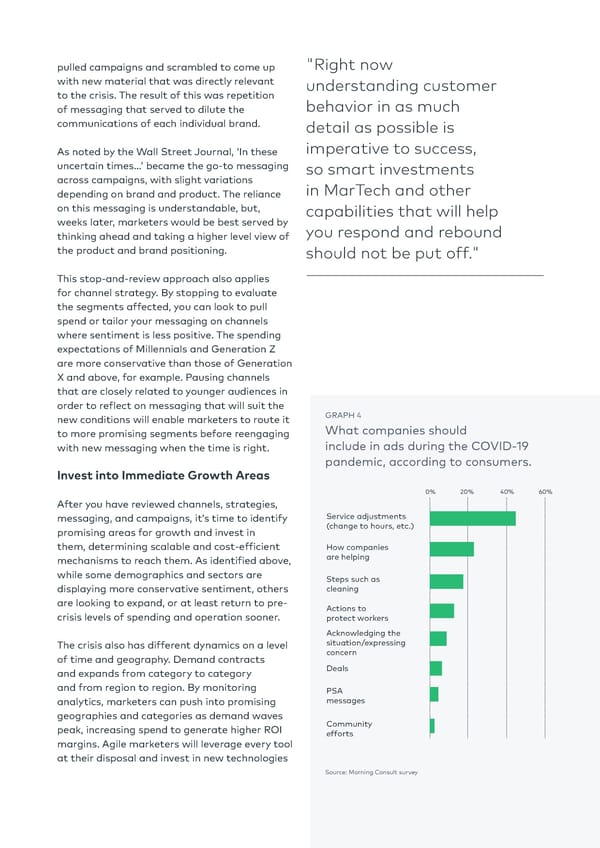
that will help them achieve scalable and cost- communications strategies, with many caught efficient growth. It is crucial to track and unawares and left scrambling for the right analyze in real-time the new emerging customer messaging. As the recovery starts to pick up, journeys and adapt both your product and your staying on top of sentiment and checking in communication strategy to meet current needs. with leaders at regular touch points will put This needs to happen on an agile basis, so it you in a stronger position and decrease the can be adapted again and again as necessary. likelihood of potential pitfalls. Listening tools Data-powered personalization technology can enable real-time response and adaptation, enables businesses to do exactly this. Facundo and provide a means through which you can Viguie Aleman, CMO of travel aggregator Omio, get an accurate picture of how well your highlights the importance of this: “You need to communications strategy is working. have the right data infrastructure in place and be able to adapt your predictive models.” Capture Value Plays Reassess Communications Strategy In line with attempts to optimize for immediate gains through identifying demand, apply a Previously effective communications strategies similar strategy to defend market share. Shift have likely already been undermined by the to digital channels with high availability and crisis. Work closely with public relations inventory and user stickiness, while avoiding professionals and leadership to bring a uniform high sentiment channels or those focused on and well thought out approach here. The early longer-term brand building. weeks of the crisis brought a rapid set of GRAPH 5 More Gen X and older consumers intend to return to or exceed their pre-COVID-19 spending–and to do so sooner–in the rebound period Example: Germany (trendv is consistent across markets) Spending expectation if the virus is under control in 6 months (%) For those planning to spend at levels the same as or greater than they did before the outbreak, older consumers expect to return to Higher Same Lower these levels faster. Expect to spend the same or more immediately (%) 8 Gen Z 64 and millenials Gen X 76 and older 64 For those planning to spend at lower levels than they did before the outbreak, younger consumers expect to reach this “new normal” faster. Expect spending to return to lower level or new normal within a few weeks (%) Gen Z 50 and millenials 28 Gen X 38 and older Source: BCG COVID-19 Consumer Sentiment Survey, March 27-30, 2020 (N=3,085 Germany), unweighted, representative within ±3% of Germany census demographics. Note: Question text: “If the coronavirus were to be under control in 6 months, what do you think your spending habits would be at that point in time?” and “If the coronavirus were to be under control in 6 months when do you think your spending habits would return to ‘normal’ (i.e., similar to before the outbreak)”? Data is similar for respondents who answered the same question with reference to a one-month or three-month time frame.
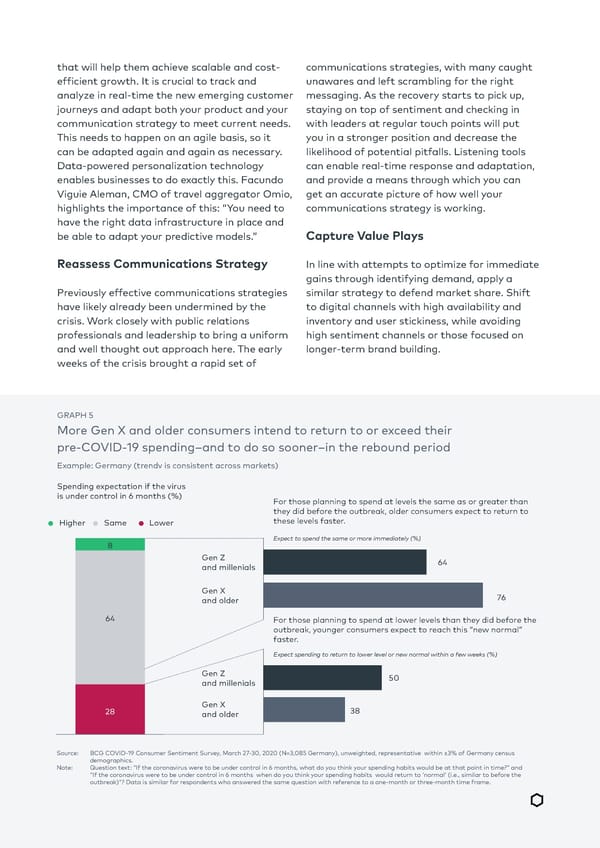
02 REASSESS PRODUCT /MARKET FIT Define or Adjust New approach consisting of frequent, data-informed Value Proposition reassessments will help you adjust to best engage with your customers. While it’s unclear what the world will look like once things start to return to normal, we can Undertaking a comprehensive review of your be sure that consumer and buyer needs will product and how consumers and buyers have have changed. Our research suggests that changed their engagement with it is the first while consumers are resilient to crisis, returning step in dialling in a new conception of product/ to regular behaviors once the acute phase of market fit, updated to fit new needs. It’s a good the crisis is over, “the COVID-19 crisis is less of idea to go back to the core; draw up a list of a point-in-time event than many other crises assumptions about your product’s interaction are, and reminder events and data are likely to with the market and look at how each has continue flooding the news daily for some time changed. It’s time to return to those core to come. As a result, it may take a while for questions: Who is your product for, and why do consumers’ natural resilience to activate and for they need it? their pre-crisis behaviors to return.” This makes adjusting and projecting difficult. Beyond customer needs, the paths through which customers get to the purchasing There are, however, steps you can take to assess point has also changed; physical interaction how immediate and medium-term changes is no longer an option, and the ways in will affect your product, and taking an agile which customers engage with products has GRAPH 6 Most consumers feel that life has changed profoundly and will never be the same. 70% 50% of consumers feel that their lives are believe that things have changed permanently different today than pre-virus and will never be the same as before 100 50 86 83 83 83 70 61 65 64 61 51 0 UK Italy Canada US France UK Italy Canada US France Source: BCG COVID-19 Consumer Sentiment Survey, April 24-27, 2020 - global.
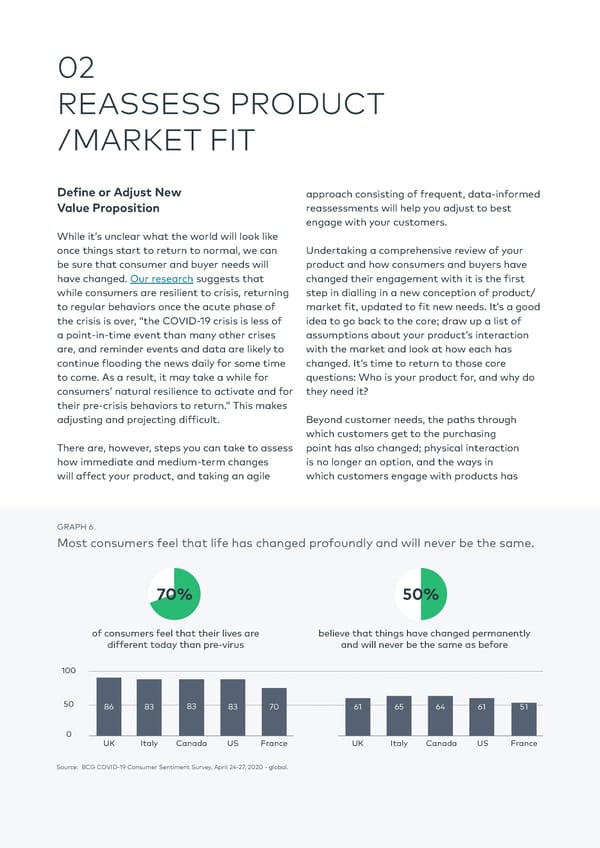
fundamentally altered as a result of sentiment The ideal first step is to establish a data-driven changes. process within the organization that analyzes different data points and thereby constantly With consumer sentiment far more sensitive builds up knowledge about the customer. It is than before the crisis, engagement on a deeper then key to incorporate this knowledge into level is more important than just encouraging all areas of the organization to jointly work the customer to buy the product. This means towards a personalized customer experience. doubling down on personalized customer journeys and experiences in order to build a Closely Monitor Sentiment lasting relationship, thereby offsetting the and Behavior Changes disruption caused by shifting sentiment. This also sets you up well for the longer term: While Reviewing product/market fit, customer journey, customers and buyers might not be ready to and value proposition might be approached continue spending right now, cultivating a from a set of qualitative assumptions initially, strong relationship will position you well for the but it’s vital to understand customer behavior rebound once confidence returns. and engagement on a deep quantitative level to test your assumptions and change as soon as Underpinning this should be an adjustment of behavior changes. value proposition. Look to the deeper level of connection your product might be able to find Establish a data-driven process within the in the market, beyond its first-level use. It exists organization to analyze different data points in a rapidly changing and uncertain world, and and get a firm, evidence-based idea of how an effective value proposition needs to take this your customers are thinking. Social media into account. listening tools, sentiment analysis, and message testing through advertising analytics will all Getting these elements right is essential. be useful, as will synching with the rest of your At DV, we’ve assembled over 400 customer organization. Personalization is also key, and journeys and executed many product/market fit a well set-up CRM that leverages consumer assessment cycles, so we know how important and buyer engagement points, enabling you to these elements are in any successful growth gauge the success of your new messaging or strategy. Even if they were working well for you value proposition, will help you foster customer before, now is the time to take stock and pivot relationships and understand how to move them to respond to the new circumstances. forward. Javier Perez Moiño, Managing Director and These tools should, while not losing sight of the Partner at BCG, has worked with leading bottom line, give you an idea of the experiences brands in industries including telecoms, travel, your customers are having. Establishing an banking and utilities to support their digital experienced-based relationship with your transformation. He recommends cultivating customers will help you understand their needs a deeper relationship with consumers and better in order to stay ahead of developing buyers, based on personalization and consistent demand, and cultivate a stronger level of engagement: “Instead of simply trying to sell connection beyond utility. “Marketed products something, marketers should focus on having run the risk of just being perceived as one out a meaningful impact on the consumer. Develop of many options in the consumer’s eye. So the the ability to provide a personalized experience Return on Experience (ROX) should even get a and then turn the consumer to a client in the higher priority than the ROI,” said Javier Perez right moment. Companies should not only be Moiño. there at the point of sales, but be present in diverse moments which matter to people.”
03 OPTIMIZE OPERATIONS Connect with Teams The experience of Omio CMO Facundo Viguie and Stakeholders Aleman highlights the importance of being With changes in progress across the radically honest and transparent during this organization, staying on the same page as period. As a company in the hard-hit travel stakeholders outside of your marketing time is sector, Omio went through rapid changes to incredibly important. Supply chain disruptions, adapt to the new environment. This took a new or changed product offerings, and commitment to transparency: “We needed to be financial considerations will have implications transparent, honest and clear, and to make sure across teams. Stay connected to synchronize everyone understood the background to every operations. decision.” Communicate clearly and often, tightening Introducing new tools and frameworks, perhaps your meeting cadence with teams and informed by those you’ve used while working stakeholders to manage adjustments in real remotely, can be deployed to encourage a truly time. Daily check-ins with the teams you’ll cross-functional and collaborative working need to work with most often, like finance process, enabling you to move quickly and gain and product, are advisable at this point. The the insights and skills that aren’t available inside product team in particular should be brought your immediate marketing team. Collaborating in close, and be encouraged to work with you with data scientists to work through customer on adapting offerings or ideating on new spending patterns might be one example, concepts; disseminating the demand insights working with the development team to test and you’re continually generating to the rest of the implement ecommerce optimization would be company, particularly the operations team, will another. Put in place a loose but transparent help the whole company to allocate resources structure like the one below to encourage and budget effectively. accountability while staying agile. GRAPH 7 TEAMS Self contained x-disciplinary Agile, dedicated, pods pm, designer, data co-located teams scientist, engineers Break down silos across Marketing, Loyalty, CRM SYSTEMS 1 2 DATA Analytics, Creative Studio, Simple & robust data Ingest internal & external Digital and IT teams architecture for analysis data sources 1% rule & testing 1% gains every week, plus step-change insights to 3 double performance every year ORGANIZATION Freedom to experiment, move quickly & create access to capital

“The ultimate goal is to become a fully ‘virtual confidence. At Omio, for example, putting organization’ with a multidisciplinary team in place and maintaining data infrastructure setup and without formal reporting lines,” said is crucial. Every aspect of the business is Javier Perez Moiño. connected in order to make sure there are enough data points for automation and Agile Budgeting algorithm training. This enables the company to respond immediately as circumstances change. You should be leveraging every tracking tool at your disposal to monitor spend and Overcoming complexity and creating efficiency performance, and your finance team will likely is another reason to invest in automation. be very interested in this information at a time A recent survey commissioned by Adjust like this. Work with them to project revenue found that marketers have to manage over and synchronize on budget; because market 250 distinct bids and spend limits every day, conditions have changed so much (and will highlighting the scale and complexity behind likely continue to do so), budgets should be current marketing campaigns, and it’s no agile, enabling you to increase spend when surprise respondents also cited repetitive you need to on short notice in order to capture workflows as a top pain point. Christian opportunities, shifting resources to higher ROI Henschel, founder and CEO of Adjust, sees areas. automation as a way to boost creativity and sharpen strategy by letting machine learning Test, Test, Test handle routine tasks and integrate various data streams together: “The future marketer won’t Agility and experimentation are the best routes compete with AI so much as co-create with it,” to swiftly adapt to the new conditions and he said. make further changes to keep up with the circumstances. Running multiple tests on digital channels with messaging options won’t just help you sell more products through optimization; in this period, it’s an invaluable tactic to inform product pivots and value proposition work, helping you to position yourself as well as possible. Automation will unlock speed, with data- evidenced insights deployed instantaneously to increase margins. Higher-level testing initiatives and pilots, run throughout the organization, will enable you to make bolder moves with
04 LEVERAGE TECHNOLOGY, CAPTURE DIGITAL GROWTH OPPORTUNITIES Become Truly Customer-Centric, everything they can to protect and grow market Double Down on E-Commerce share. Investment in technology that enables a smoother e-commerce experience, and Getting customer experience right is now even brings customers in before your competitors higher stakes. Due to the closures of many by identifying relevant audiences through physical stores, digital channels are now central, digital channels, is the way to win. Automating with Internet use higher. operations, particularly on ad spend, will help you move instantaneously as conditions change. Demographic shifts towards digital, with older audiences forced to use digital channels But the deployment of technology also needs for the first time, mean every experience can to follow a well considered and deliberate potentially pose a threat to retention; first-time strategy. It’s less about individual features and experiences carry more weight than those of more about concrete use cases. Before you start digital natives, for whom experience is less of a building (or updating) your marketing stack, it’s hurdle. crucial to devise your overall business strategy. This approach must be shaped around the With this in mind, making the e-commerce value proposition, product portfolio, the desired experience as easy as possible will lead to audience, and the channel mix employed to reach them. Carefully analyze your current stack customer retention. Right now, many businesses and identify where it matches the strategy and whose physical stores and operations were their where it blocks it. primary channels are having to compete with Amazon. A good customer experience could be the difference between a new, loyal customer or the loss of existing customers, who have "Demographic shifts towards now become used to digital channels and will digital, with older audiences consume less in-person even once the crisis abates. forced to use digital channels Traditional retailers, who are less equipped to for the first time, mean every serve people immediately at their homes and experience can potentially whose delivery times will be longer, are at risk of pose a threat to retention; losing their market share over time. first-time experiences carry Tracking customers throughout the flow to more weight than those of understand potential bottlenecks, testing digital natives, for whom messaging and adapting accordingly, and increased personalization and data enablement experience is less of a hurdle." to identify earlier openings will help you win against competitors, who will also be doing
Focus on Digital Media Buying The alteration in market sentiment and new Opportunities, New Formats customer experimentation with formats such as video consultations and streamed events also Ad spend declines up to 50% are expected provides an avenue for exploration. Webinars, across all channels, according to advertising podcasts, live streams, social streaming, and professionals. Digital media is likely to retract by other channels are all fresh ways to reach your around 40%, with social media and paid search customer base and engage with them in a way down by 33% and 30%, respectively. CPCs are that’s hyper relevant in the current moment. down and CTRs are up across the board. Given sensitive consumer sentiment, these formats are also vital, as they are less direct CMOs will need to be smart about spending; and more educational. Content marketing part of the reason for these changes is the will be a vital tool to your new strategy, and increased amount of inventory available that investments should be made where it makes mirrors the greater periods consumers are sense to understand what works and what spending online. With so many new consumers doesn’t and to optimize for SEO given the and buyers there to be reached at a diminished increases in search traffic. price, there’s a huge opportunity to find LabTwin, a company whose product is a voice new customers. By being smart and using assistant for scientists and researchers, has technology, you can find exactly where these invested in content as a means to educate and new customers might be and reach them with inform clients “We have always invested in laser-focused targeting. Investing in smart content and offered an eloquent perspective for advertising platforms that integrate with your our clients,” said Magdelena Paluch. “Our focus e-commerce and CRM solutions and deploying was already educational, and now is the time to heavy data analysis is the best way to get really double down on that.” the most out of your operations and take advantage of the low price of advertising. Get this right and you’ll see your acquisition costs decrease. "Our focus was already educational, and now is the time to really double down on that.” MAGDALENA PALUCH, CEO, LABTWIN
05 PLAN AND INVEST Baseline Scenario Planning, Immediate- and Mid-Term 14 different networks, and listed merging and acting on disparate sources of data, individually The landscape for marketers is still fraught updating bids and budgets, and accurate and unpredictable, with a difficult economic campaign management as their three biggest landscape likely to take hold after the crisis pain points. period is over. Nonetheless, planning needs to start as soon as possible. Working with the Renegotiate with Providers finance department and leadership on a set of scenario plans that are informed as much With markets facing so much disruption and as possible by sales and engagement data costs being squeezed across the board, it that you’ve generated will help to stabilize makes sense to reevaluate vendor and provider assumptions from all sides and set the company contracts and relationships in parallel with up to weather the storm, adapting to the reviewing channel strategy. circumstances and avoiding any surprises. There may be platforms or tools that no Invest longer fit with your strategy; contact vendors directly to understand if there’s any room for Scenario plans need to include scope for cost negotiation. Doing so will enable you to investment. Assuming that the rebound will redirect funds into investment areas, giving lift all boats equally is not enough; marketers you the room you need to establish new digital need to put themselves in the position to capabilities. perform. The crisis has shown the importance of emerging technologies in enabling marketers to unearth opportunities and value that is vital for success even in tough times. This lesson must be learned for the future: Smart investments into innovative technologies such as automation, data analytics, e-commerce optimization, and many more are not optional extras but central to rebounding strongly and protecting and expanding market share. The importance of this point is evidenced by new research by Adjust, which found that 81% of marketers said their company was planning to increase its marketing or advertising automation budget in 2020. The study also highlighted the complexity of campaigns and marketers’ difficulty managing them: Marketers were found to handle an average of 19 advertising campaigns across approximately

Detect Recovery Signs While the macroeconomic conditions are likely to be changeable for the longer term, there are a specific set of issues, such as supply chain disruptions, non-travel orders, and lockdown measures, that are likely to ease in the short to medium term. Specific sectors that have been hard hit by the crisis for direct reasons, including consumer categories such as fashion, are likely to see improved sentiment in the coming months. Detecting the signs of this recovery and moving at the right time to take advantage will be incredibly important for marketers looking to reestablish their market positions and increase sales as soon as possible. Obviously some of this lies in monitoring news channels, but tools that can detect upshifts in revenue and track sentiment changes will enable smart marketers to move quicker and with more confidence. Social media monitoring, data processing and projection, and sentiment analysis are part of this toolkit, and the cost of investing in the latest technologies will be offset by revenue and increased market share. “You need to have the right data infrastructure in place to be able to adapt your predictive models, and fully integrate with customer service, looking at every single ticket raised." FACUNDO VIGUIE ALEMAN, CMO, OMIO


Key Takeaways The COVID-19 crisis and its associated conditions have disrupted marketing operations to an unprecedented extent, and the coming months will continue to throw up new challenges that are difficult to predict with any confidence. But the changes that have taken place have demonstrated one thing clearly: Digital technologies will take center stage in the new marketing landscape. We’ve seen how marketers who are well set up to function online, who prioritize data analysis, automation, and make decisions based insights provided by bleeding-edge solutions, are well positioned to come out of the crisis having protected their market share as best they can, with a product offering that has adapted to the market at great speed. Others, who did not have these capabilities in place, have far less of an idea of how to best reach their customers, how to best manage their budget, and how to match market sentiment. The coming weeks, months, and years will reward marketers who now learn the lesson this crisis has presented them with. Building technological capabilities is not an area of marketing and sales that can now be thought of as optional, something nice to have for those who can afford it. Technology and marketing now go hand-in-hand. Realizing this and doubling down on innovation is the strategy which will best serve marketers in a post-COVID-19 world, setting them up not just to survive in the short term, but to thrive in the future. "Marketing and sales leaders need to do everything they can to understand how their buyers and consumers have adapted to the post-COVID-19 world, and meet them where they are, leveraging technology to keep track of behavior and using it to inform campaigns, messaging, and, most importantly, product/market fit adaptations."
About the Authors authors Amaryllis Liampoti Amaryllis is a senior leader with a track record in driving scalable growth for B2B and B2C businesses. With a passion for data driven marketing and product development and a truly global perspective, Amaryllis has honed a wide breadth of skills in her more than 15 years of working in digital. Today Amaryllis serves as Partner and Director of Growth at BCG Digital Ventures. She focuses on scale-ups and growth acceleration for digital businesses. Amaryllis came to DV with a diverse background in founding and scaling technology driven businesses and in key leadership roles at innovative companies across Europe. Notably, she served as Vice President of Marketing at Rocket Internet SA, where she led the development of growth strategies, from seed phase to market leadership for new and existing ventures of the German incubator. She was also part of the founding team at Campsy.com, where she oversaw the company's growth in her role as co-founder and CMO. Nils Christian Melcher Nils is a Managing Director and Partner at BCG Digital Ventures and angel investor with extensive experience in launching and scaling digital business models. He has a 17+ years of experience within digital, starting his first e-commerce experience in the mid 2000s. Nils has a passion for data driven customer acquisition topics ever since his work at a mobile gaming startup. Today, Nils serves as the leader of the CEMA Consumer & Retail practice within BCG Digital Ventures and focuses on building corporate-backed e-commerce business models for both B2B and B2C. Nils joined DV with a previous career in digital consulting as well as startup experience. He worked for 9 years as consultant focusing on digital transformation for Booz & Company and served as Head of Mobile Technology at Aeriagames (previously owned by Pro7Sat.1), where he led the mobile gaming business.
Acknowledgments Javier Perez Moiño Javier is a Managing Director and Partner at Boston Consulting Group and works with leading brands in industries including telecoms, travel, banking and utilities, to support their digital transformation. By helping clients to identify the optimal digital marketing channels mix, and designing and delivering the best personalized experiences in those channels, he helps brands turn outstanding digital experiences into tangible business results. To further secure their digital advantage, Javier works with clients to help them redefine and evolve their organization and operating models. Magdalena Paluch Magdalena is the co-founder and CEO of LabTwin. She is a passionate design-driven entrepreneur with over 14 years of hands-on execution experience in building and leading cross- disciplinary teams in an agile fashion. Magdalena leverages emerging technologies to build products that solve problems for individuals and organizations in a transformative and people-led manner. In her previous role as Director at BCGDV, she was responsible for building up from scratch more than ten corporate-backed startups and innovation initiatives in Europe and the U.S., primarily focused on the healthcare space. Before joining BCGDV, she worked as a Senior Innovation Strategist at Toyota, where she was responsible for identifying and implementing emerging technologies in mobility and robotics such as autonomous vehicle design. Facundo Viguie Aleman Facundo is the Chief Marketing Officer of Omio. Before joining the company in early 2019 he worked in the German start-up ecosystem as SVP Growth for HelloFresh and VP Marketing for Rocket Internet. Originally from Argentina, with a business education background, he started his marketing career in 2008 at MercadoLibre where he led the acquisition marketing department. Christian Henschel Christian co-founded Adjust in 2012, and under his leadership, the company has expanded across the world, reached profitability in under four years, and is today recognized as a major player in the mobile marketing ecosystem. Now counting 500 employees across 16 offices, Christian is heavily involved in shaping the company culture, establishing opportunities for growth, and managing Adjust's development into new territories and technologies. Prior to founding Adjust, Christian worked in Madvertise's management team and headed up the digital revenues department at MTV Networks.
About BCG Digital Ventures BCG Digital Ventures (BCGDV) is the world's largest company builder. The company invents, builds and scales new business models and start-ups together with leading global corporations, helping them to break up their traditional structures. Multidisciplinary teams of software developers, product managers, strategic designers and growth experts develop digital business models and incubate, test and manage their operation. BCGDV has now launched more than 100 "corporate ventures" - and is itself an investor in some of them. Read all the latest from BCG Digital Ventures on our blog here. Find us on Linkedin and Twitter. Check out Buildcast, the new podcast from BCG Digital Ventures. We just released a series of short episodes covering how different sectors are responding to the COVID-19 crisis. You can find it on Spotify, Apple Podcasts and Soundcloud. For inquiries, please contact: [email protected]








